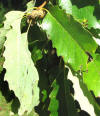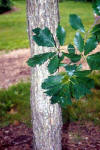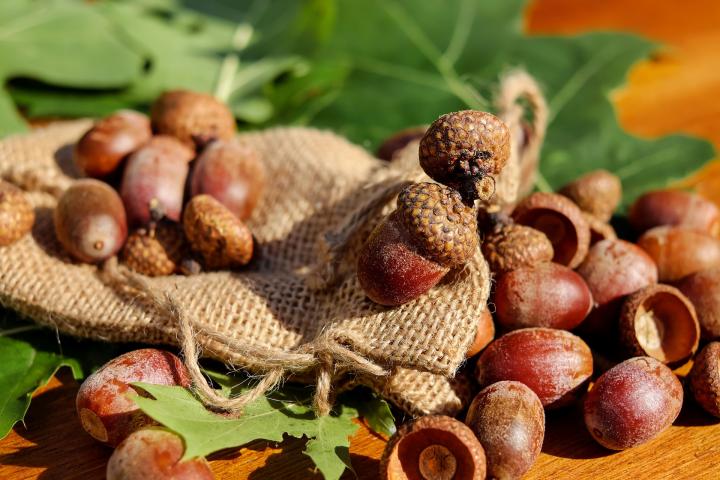WILD
FOODIES' HOME PAGE
PLANT PROFILE LIST


NAME:
Chinquapin
oak
SPECIES /
FAMILY: Quercus Muehlenbergii / Fagaceae
OTHER COMMON
NAME(S):
CONDITIONS:
sun-partial shade
|
PARTS: |
EDIBLE  |
TASTE |
RAW/COOK |
SEASON |
|
All |
|
|
|
|
|
Shoots |
|
|
|
|
|
Leaves |
|
|
|
|
|
Stalk/Stem |
|
|
|
|
|
Buds |
|
|
|
|
|
Flowers |
|
|
|
|
|
Fruits |
|
|
|
|
|
Pods |
|
|
|
|
|
Seeds |
 nut nut |
sweet |
COOK |
Oct |
|
Nuts |
|
|
|
|
|
Roots |
|
|
|
|
|
Bark |
|
|
|
|
PORTION: small
COMMENT: Not to
be confused with the Chinquapin Chestnut (2,3) and rare in PA(7). Seed -
contains very little bitter tannin, it is quite sweet and rather pleasant
eating, tastes nice when baked in an oven. Any bitter seeds can be leached by
thoroughly washing the seed in running water though many minerals will also be
lost. Either the whole seed can be used or the seed can be dried and ground it
into a powder. It can take several days or even weeks to properly leach whole
seeds. Roasted seed is a coffee substitute.(1) For more preparation ideas, see
#8 below.
To process them, first put them in water and discard any that float.
CAUTION:
NUTRITION/MEDICINAL:
The chinquapin oak is especially known for its sweet and palatable acorns.
Indeed, the nuts contained inside of the thin shell are among the sweetest of
any oak, with an excellent taste even when eaten raw, providing an excellent
source of food for both wildlife and people.(3)
Antiemetic;
Astringent. An infusion of the bark has been used in the treatment of vomiting.
Any galls produced on the tree are strongly astringent and can be used in the
treatment of haemorrhages, chronic diarrhoea, dysentery etc.(1)
LOOK-A-LIKES:
Related Oaks: red
/
pin
/
white
POISONOUS
LOOK-A-LIKES:
OTHER USES:
Fuel; Repellent; Tannin; Wood.(1)
SOURCE LINKS (may
include nutritional and medicinal info, plus other uses):
1.
https://pfaf.org/user/Plant.aspx?LatinName=Quercus+muehlenbergii
2.
http://www.eattheweeds.com/tag/ozark-chinquapin
3.
https://en.wikipedia.org/wiki/Quercus_muehlenbergii
5.
https://nature.mdc.mo.gov/discover-nature/field-guide/chinkapin-oak-chinquapin-oak
6.
http://wildfoodshomegarden.com/Oak.html (good summary of various oaks)
7.
https://www.fs.fed.us/database/feis/plants/tree/quemue/all.html#DISTRIBUTION%20AND%20OCCURRENCE
8.
https://www.almanac.com/content/how-prepare-and-cook-acorns How to
prepare acorns

HOW TO PREPARE ACORNS:
https://www.almanac.com/content/how-prepare-and-cook-acorns
Have you ever wondered if the squirrels might be onto something? In fact, they
are! Acorns are extremely nutritious and readily available in nature, making
them a healthy addition to many recipes. Here’s how to prepare
and cook acorns!
Why acorns? They are incredibly nutritious, offering healthy levels of
carbohydrates, protein, and fiber. Surprisingly, they are also a good source of
Vitamins A and C.
Plus, they have a wonderful rich, nutty taste. Also, why not? It’s fun to forage
and try making something adventurous.
Acorns have been a staple of diets around the world and across cultures,
including among some Native Americans.
While most folks use acorns to make a nutrient-rich, nutty-flavored flour, you
can also eat acorns as roasted nuts (they are a lot like chestnuts). See more
ideas below!
WHERE AND WHEN TO FIND ACORNS
Acorns come from oak trees, which can be found across North America. Oak trees
are easily identifiable—they’re the ones with all the acorns around them! Jokes
aside, oaks have fairly distinctive leaves and bark; look up which species of
oak trees are common in your area to know exactly what signs to look for.
Acorns are typically harvested between September and November, when they fall
from the trees and become easily accessible to deer, squirrels, and
resourceful humans.
HOW TO COLLECT ACORNS
When gathering acorns, look for brown, fully mature acorns that still have their
caps, as those without caps are more susceptible to infestation by worms and
other critters.
Green acorns are not yet mature and shouldn’t be used. If you’re willing to
wait, consider harvesting acorns this year and storing them in a cool, dry place
until next fall, when they’ll be fully dried and easier to work with.
HOW TO WASH ACORNS
-
Give acorns a quick rinse in cool water. Place them in a
pot or bowl and fill it with water, then remove and dispose of any floating
acorns, as they have likely gone bad.
-
Place the acorns in a colander and run them under the tap
for a minute or two to dislodge any loose dirt or hitchhiking bugs.
-
Set the colander aside to let the acorns air-dry, or simply
dry them by hand with a dish towel.
-
Remove the shells and caps from your acorns with a
nutcracker (or a hammer, if necessary). Do not eat the raw meat of the
acorns yet.
HOW TO LEACH ACORNS
Acorns contain bitter-tasting tannins, so you must prepare, treat and cook the
nuts before you eat them. It sounds like a pain but it’s really not
that difficult.
-
Start two pots of water boiling. Drop the raw,
shell-less acorns into one pot and boil until the water is the color of strong
tea. Strain the nuts through a colander and drop the strained nuts into the
second pot of boiling water. Discard the dark water from the first pot, then
refill it and bring the water to a boil again. Repeat the process without
interruption (do not let the acorns cool) until the water boils clear. This
may take an hour or more, depending on the variety of acorn.
-
Alternatively, you can soak the raw acorns in cold water to
leach the tannins out. Change the water when it turns a darker color. This
process may take several days, depending on how long it takes for all the
tannins to leach out of the acorn meat.
To avoid rotting, it’s very important that the acorns dry fully. Spread
tannin-free acorns to dry on cookie sheets in a warm place. If it is hot out,
lay the cookie sheets in the sun. Or, you could put them in an oven set to
“warm.” You can also put the acorns in a dehydrator set on low heat.
EATING ROASTED ACORNS
Making acorn flour isn’t the only way you can enjoy acorns. Here’s how to roast
the nuts:
-
Preheat your oven to 350 degrees Fahrenheit.
-
Pour the acorns into a single layer on an ungreased, rimmed
cookie sheet.
-
Cook the nuts for about 60 minutes or until they turn a
chocolate brown color.
-
Remove the acorns from the oven and let them cool. Salt
to taste.
HOW TO GRIND ACORNS FOR FLOUR
When partially dry, coarse grind a few acorns at a time in a blender. Spread the
ground acorns to dry on cookie sheets, then grind again in a blender. Repeat
until you are left with a flour- or cornmeal-like substance.
You can also freeze your fresh acorn meal. Store dried flour in jars in
the fridge.


